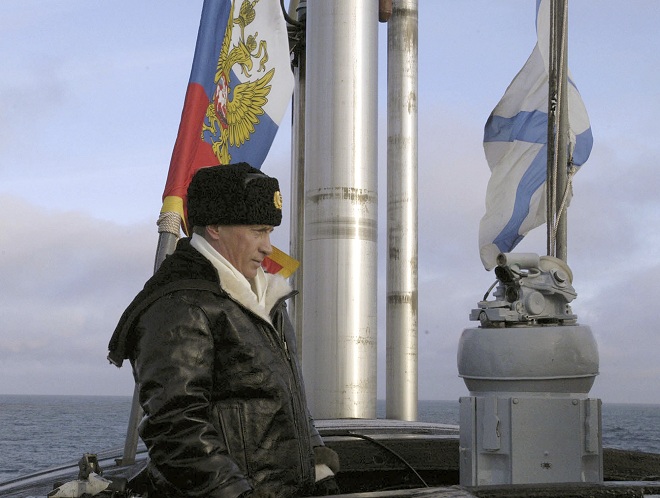
Russian President Vladimir Putin aboard the nuclear submarine Arkhangelsk in 2004. Photo: AP
– Putin Preps Russian Navy for Biggest Exercise Since the Soviet Union (Wired, Jan 3, 2013):
The Russian navy is about to stage its largest war exercise in a long time — possibly the largest since before the breakup of the Soviet Union. It’s a chance for President Vladimir Putin to show off his military might, of course. But the exercise may also be a subtle warning to the United States: Stay clear of waters that traditionally lie in Russia’s sphere of influence.
The Russian defense ministry says its the “first time in decades” it’s launched naval exercises on this scale. The drills involve warships from all of Russia’s fleets: “the Northern, Baltic, Black Sea and Pacific,” noted a statement from the ministry. The exercise will be reportedly held in late January, and involve amphibious landings in the Caucasus and naval exercises in the Mediterranean.
Putin has undertaken a major $659 billion arms buildup through 2020. On Thursday, the Defense Ministry in Moscow also announced the scale of its ongoing naval increase. By 2016, a statement noted, Russia will have 18 new warships, “and also 30 special-purpose and counter-subversion vessels,” along with six new submarines. One of these vessels, the Borei class ballistic missile sub Yuri Dolgoruky, joined the fleet this week.
What’s odd is the timing, and location. The choice of the Black Sea and Mediterranean has led to some speculation that the exercises are cover for an evacuation of Russian citizens from Syria, with estimates ranging from 9,000 to 30,000 people. Could be. Syria’s civil war has been drastically getting worse. But Russia also has more practical reasons for putting on a show of force in area. As far as some in Moscow see it, the Black Sea is under threat.
In November, Anna Glazova, a military analyst at the Russian Institute for Strategic Studies, wrote in the Russian defense magazine National Defence that the U.S. is seeking to “take military control of the Black Sea region.” The evidence: Washington has moved to install missile defense interceptors in Turkey and Romania — ostensibly to shoot down Iranian missiles — but with the Russians seeing it as aimed at them. Romania and Bulgaria joined NATO in 2004, which in Moscow’s eyes, meant “the Americans actually took control of the western Black Sea coast,” wrote Glazova.
That’s a bit strong. The U.S. has been restricted by treaty since 1936 in the number of warships it can sail through the Turkish-controlled Bosporus Straits, and how long Washington can keep them in the Black Sea. On the other hand, over the past two years, U.S. cruisers have visited ports in Ukraine and Georgia. Among them included the cruisers Vella Gulf, Philippine Sea and Monterrey, each equipped with Aegis ballistic-missile defense systems.
But the Black Sea is a great setting for this drama to play out. Historically, it’s in Russia’s backyard, so to speak. But the U.S. isn’t about to send an aircraft carrier into the sea to help out Georgia in the event of another war. During the 2008 war between Georgia and Russia, the Pentagon planned to send two hospital ships into the sea, but were blocked by Turkey. (Istanbul doesn’t allow more than 45,000 tons of warships into the Black Sea for countries not bordering it.) But a relative decline in Russia’s influence is enough to put on a big show.
“That leaves honor — or, more accurately, national redemption — as the main propellant for endeavors like this exercise. It’s all about demonstrating that Russia remains a sea power to be reckoned with,” says Jim Holmes, an associate professor of strategy at the Naval War College.
Later this month, we’ll have to chance to see to what extent. It’ll also be interesting to see if Putin has any surprises in store.